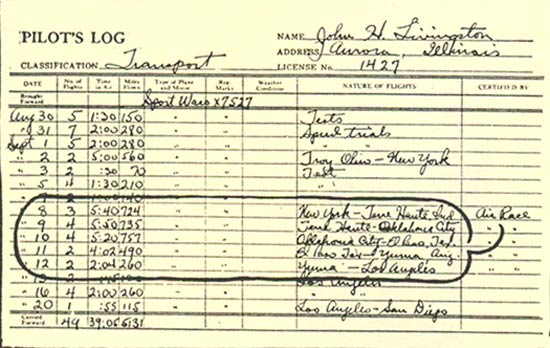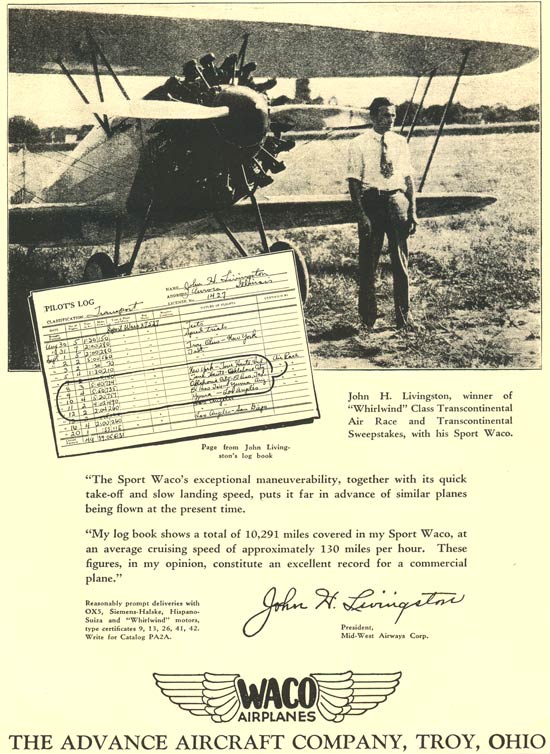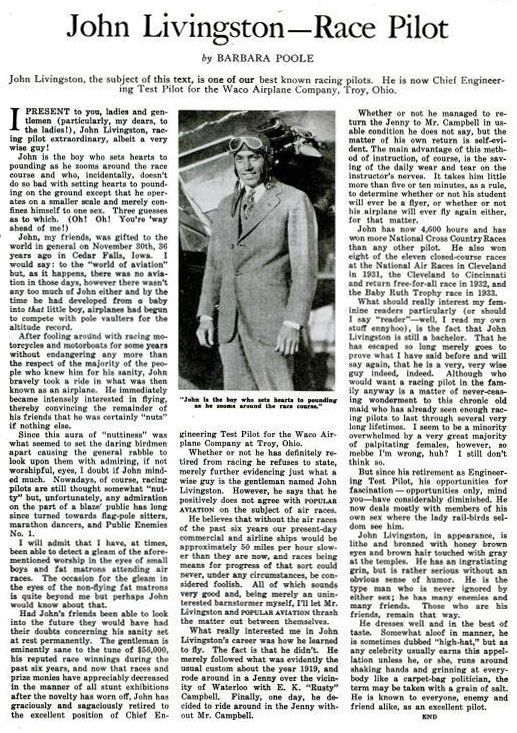|
John Livingston is reputed to be Richard Bach’s muse
for “Jonathan Livingston Seagull”. Livingston was born on November 30, 1897 and flew West on July 2, 1974. Some biographical information can be found in a three-page letter written by him and exhibited below. The next image, taken on a breezy day, is shared with us by friend of dmairfield.org, John Underwood. The Monocoupe behind him sports race number 22 on its wing tip, which identifies it as NC501W (not a Register airplane), which he flew in many races during 1930-33.
John Livingston, Date & Location Unknown (source: Underwood)
 |
Livingston landed three times at the Davis-Monthan Airfield. On
July 10,1928 he flew in solo with Ryan NC6586 enroute
from San Diego, CA to Monmouth, IL. On September 11, 1928,
he flew in with Waco NX7527, carrying passenger M.B. Allen
from El Paso, TX to Yuma, AZ. He revisited on September 21
with the same plane and passenger, headed east from San Diego
to El Paso.
The image, above, shows him with Waco NX7527 at
about the time of those flights. It is from a full
page advertisement for Waco aircraft in the February 1929
issue of “Popular Aviation and Aeronautics”.
These last two flights, as documented in the Register, were
in conjunction with the 1928
National Air Races, named “On
to Los Angeles”, which took place between New York
and Los Angeles that year. Livingston took first place
in the Class B race , with an elapsed time of 22h56m59s
for the 2,939 mile course. He won $7,000 for his victory (see the broader total of his winnings tabulated further below on this page),
plus a few minor cash prizes given by what were called “Control
Cities” to the leaders of the transcontinental race
as they passed through their jurisdiction. Close behind him,
taking second place, was E.E.
Ballough.
The image, below,
shows a page from his pilot log that identifies his flight
segments during the race. It is among these flights
that he landed at Tucson on September 11th.
Below is the full-page Waco ad from which the images above
were extracted and enlarged. See this link for
a brief biography of John Livingston.
Following his victory in the 1928 Class B race, he next
won the National Air Tour in 1929. The National Air
Tours were held from 1925 to 1931, and the 1927 Tour passed
through Tucson, with many of the participants’ names
inscribed in the Register. A biographical sketch of Livingston appears here. Parts of it are relevant to some of the photos and artifacts displayed below.
Below, from Andy Heins, is an undated image of John Livingston. This image is from Bettie Lund's personal photo album. She was the wife of Register pilot "Fearless" Freddie Lund. The airplane behind him is a Monocoupe, which, when compared to known images of the airplane, is NC501W (not a Register airplane). NC501W was used extensively by Livingston in many winning competitions during 1930-31.
John Livingston With Monocoupe (NC501W), Date Unknown
(Source: Heins)
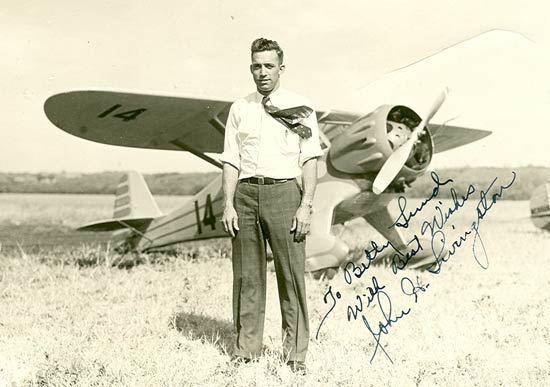 |
This link gets you a PDF
file of a small book written by John Livingston about his
experiences during the 1929 Air Tour. It includes data
on his Waco airplane (not cited in the Register), Tour statistics,
anecdotes related to some of his Tour companions, and a map
of the Tour route. For
a more general description of the National Air Tour program,
see this excellent link.
I highly recommend this site, because it is rich in relevant
material about our pilots and airplanes alike.
John Livingston also won or placed in a number of other races and events during the late 1920s and early 1930s. Below, courtesy of site visitor P. Frankel, are three photographs of an Elgin pocket watch bestowed upon Livingston in January, 1931 by the City of Hialeah, FL for his participation in the Miami All American Air Races.
Pocket Watch Prize, Miami All American Air Races, January, 1931 (Source: Frankel)
 |
His participation in the 1931 Miami race, as well as his earnings for the years 1926-1933, are documented across the two pages of his pilot log book exhibited below. Besides the watch, he earned $750 for the Miami race.
The engraving on the back of the watch is below. The lack of scratches and wear suggests the watch was never used. This source states that Livingston took, "... two first place finishes and a second" at the 1931 Miami Races. It is not clear from the engraving for which first-place event the watch was conferred.
Pocket Watch Prize, Engraving, Miami All American Air Races, January, 1931 (Source: Frankel)
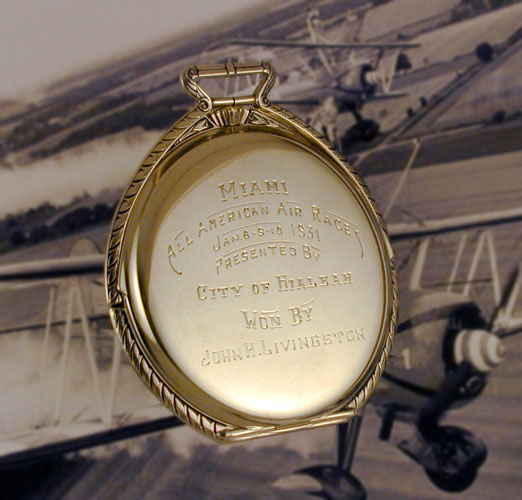 |
Below, a folding kickstand feature that allowed the watch to be supported upright for a valued position on the mantle, desk or nightstand.
Pocket Watch Prize, Miami All American Air Races, January, 1931 (Source: Frankel)
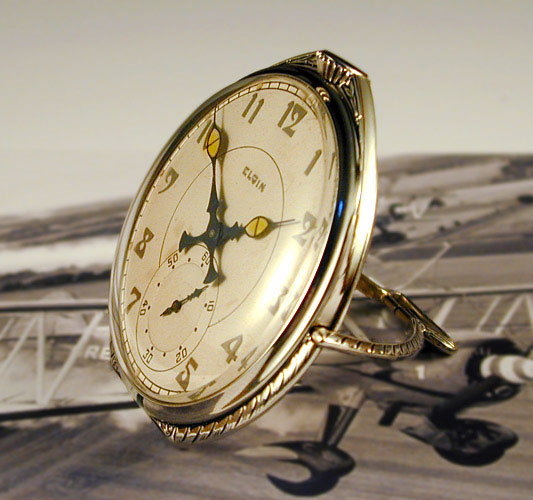 |
From March, 1935, below, Popular Aviation (PA) magazine provided a summary of Livingston's air race work to-date.
---o0o---
As of April 24, 2009, new information, photographs and documents below from Captain Steve McDonald (cited, right sidebar).
A primary artifact among Capt. McDonald’s collection is one of John Livingston’s pilot log books. Below are selected pages of this log, which illustrate particularly interesting findings. Captain McDonald and I make the entire log available for you to enjoy here (PDF, 58 pages, 254MB). Below are two fronticepiece pages with Livingston's photograph and pilot/mechanic certification data circa 1929.
J. Livingston Pilot Log Frontispiece
(Source: McDonald)
 |
Notice that he held mechanic's and glider certifications.
J. Livingston Pilot Log Frontispiece
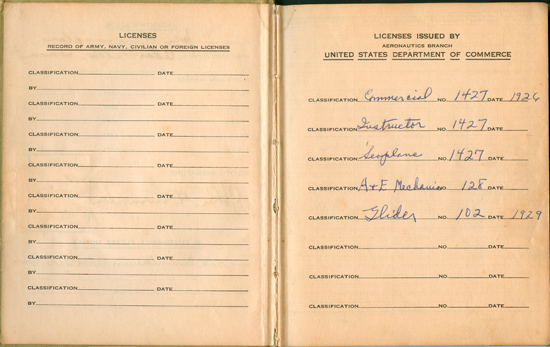 |
I suggest that you choose to download this pilot flight log. You will notice it does not record Livingston's actual flight itineraries for 1928 and earlier. That log existed somewhere, as it was used for the advertisement above. We do not know where it is today. Does anyone KNOW?
Regardless, in the log we do have, Livingston summarized his hours for 1921-1928 on a single page, below. Notice that he logged the total number of hours he flew individual airplanes those years, not the time for each specific flight. He averaged about 408 flight hours per year during those years.
He began this volume with 3,266 hours and 35 minutes of experience (since 1921) on January 22, 1929 (actually his addition is high by three hours). He ended this volume with 7,565 hours and 34 minutes on December 6, 1942, adding about 4,300 hours over the 13 years (about 330 hours per year).
Summary Page from 1929-1942 Pilot Log Book
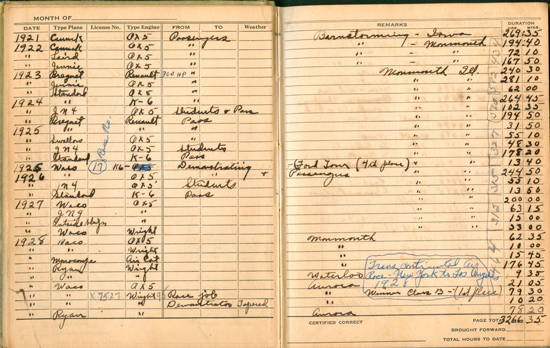 |
The only airplane he identified by number in this summary (near the bottom of the page) was the Waco NX7527, which he flew in 1928. He notes that it is a “Race job” (S/N A-33, manufactured 1928) and winner of the Class B cross-country event of the National Air Races that year. It is the airplane he brought twice to Tucson, and photos of it can be seen at the airplane's page linked above.
Note, too, that he flew a Curtiss JN-4CAN "Canuck" during 1921-22. Below, an image of him in that Canuck, the only one among Captain McDonald’s collection. This is probably one of the oldest photographs of Livingston in a powered airplane. He had experience with gliders before this.
An Early Image of John Livingston in a JN-4CAN Canuck, Ca. 1921 (source: McDonald)
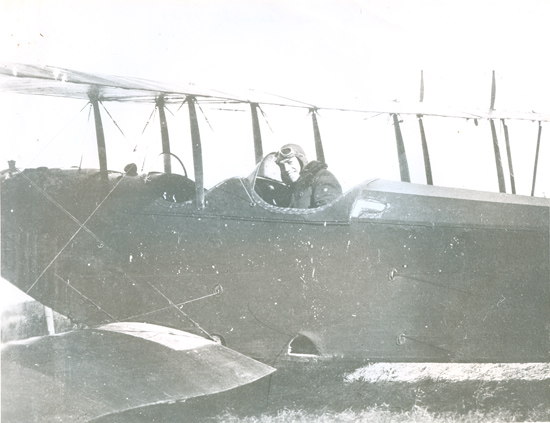 |
1926 |
$ 1,750.00 |
1928 |
$ 12,910.00 |
1929 |
$ 6,855.00 |
1930 |
$ 6,360.00 |
1931 |
$ 11,922.00 |
1932 |
$ 5,734.50 |
1933 |
$ 8,050.00 |
TOTAL |
$ 53,581.50 |
A very instructive discovery you will make as you review his log is on the last few pages. He computed, annotated and documented his gross earnings from air racing between 1926 and 1933. At left is a table of his income. If you consider the amounts of money he earned, and place them within the context of the Great Depression era, he made a very good living, indeed, from air racing. He was the one to beat.
Below are two images of the pages from his log that summarize his earnings. He calculated his total income as $53,507. His additions were slightly off for 1930 and the total at left is correct. It would be interesting to know what his net earnings were.
Earnings Page from 1929-1942 Pilot Log Book
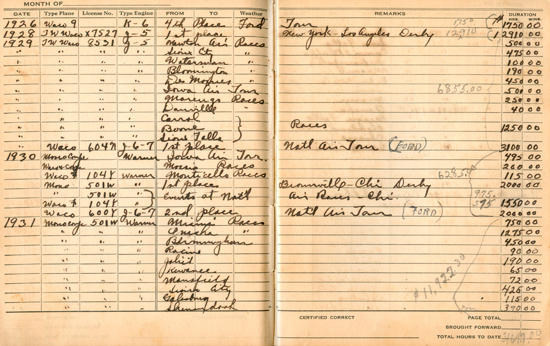 |
Earnings Page from 1929-1942 Pilot Log Book
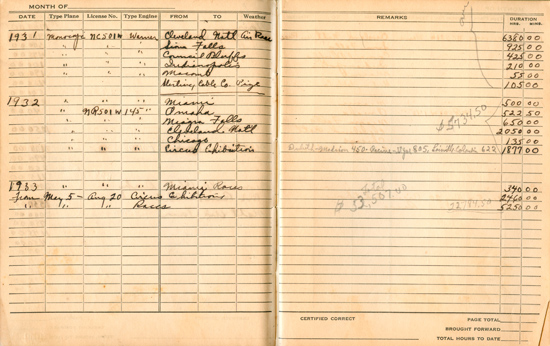 |
As we leave this flight log, with just a little study, a big picture emerges from Livingston's book. It is clearly a story of a productive and active pilot’s life. Early on he was engaged in active racing and his log entries are detailed with locations, places and elapsed times. After his active racing career, as he transitioned into his middle life, his flight activity reflected his work for aircraft manufacturers performing aircraft testing and ferry flights.
After 1934 (pp. 25-26 of the PDF), his entries became very sparse. Sometimes he summarized whole years with just a block of total hours. Later, his log grows even more sparse and cryptic. He is focused on flight instruction. He mentions his last formal racing events during 1938-39 (pp. 29-34).
In 1941, his last entry was on November 28th (p. 46). December 7th, the "Day of Infamy", went unmentioned, and the remainder of that page was left blank. He noted that he reported to the Civil Air Patrol (CAP) in February, 1942 with 7,030 total flight hours.
His next entry was on February 5, 1942. His annotations for the remainder of his log are routine and illustrate probably his flying associated with WWII CAP duties. His last entry in this log is December 6, 1942 flying an 80HP Taylorcraft.
---o0o---
Now for additional items. Below, a three-page letter sent by Livingston in response to a questionnaire distributed by the Iowa Aeronautics Commission. The date of this correspondence is not cited anywhere on the letter, but, from dates mentioned for activities throughout the text, the letter was composed sometime after 1939. This document is out of chronological sequence with what follows, because the content is biographical and it refers to some of the events and photos below it. You may download a copy of this letter here (PDF 15MB). The rest of the photographs and documents below are roughly chronological.
Livingston Questionnaire, Ca. Late 1930s, Page 1
(source: McDonald)
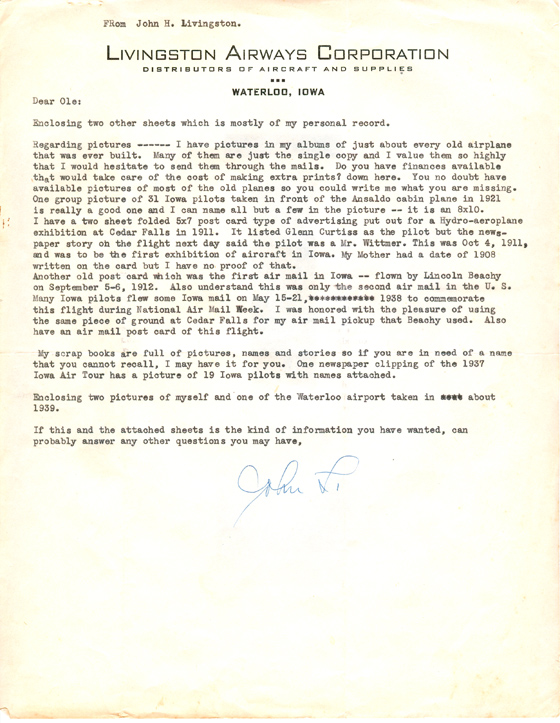 |
Livingston Questionnaire, Ca. Late 1930s, Page 2
 |
Livingston Questionnaire, Ca. Late 1930s, Page 3
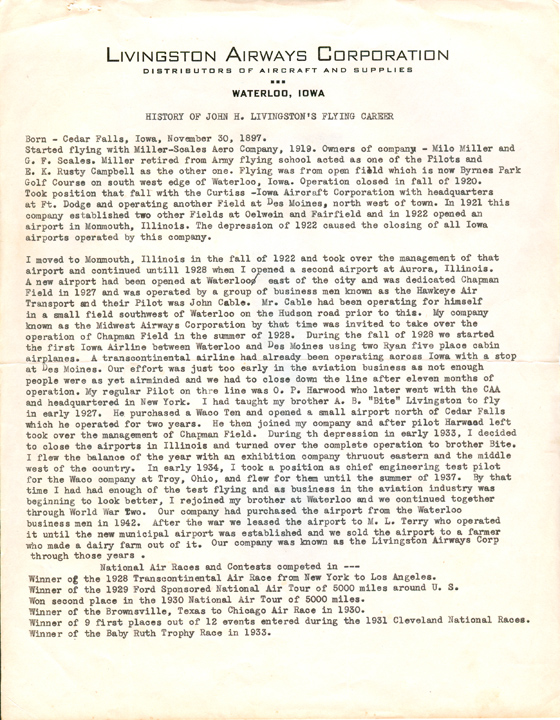 |
An additional, brief biographical sketch is here, which includes background on Livingston's brother "Bite".
Among the photographs in Captain McDonald's collection is this one of the airport at Waterloo, IA. It is the one mentioned on page 1 of Livingston's letter, above. Surprisingly, no Register pilots cited Waterloo as their home base, departure point or destination. However, it is cited as a waypoint on several pages of Livingston's flight log. It is clear he saw it in much this way during his work there.
Waterloo, IA Airport About 1939
(source: McDonald)
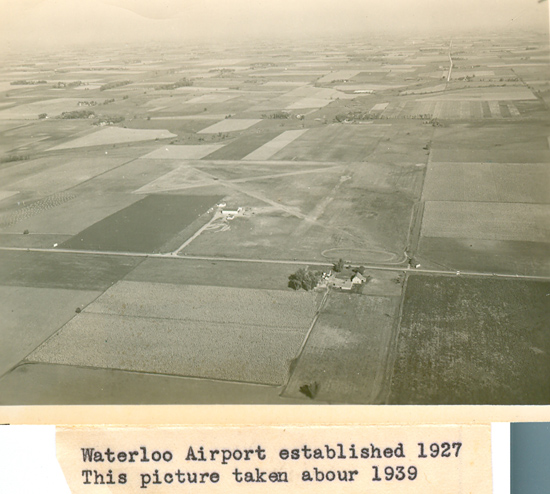 |
It is instructive to see this midwest airport among the others documented at the PLACES button at upper right. Upon magnification, there are about a half-dozen aircraft on the ramp in front of the hangar at left center, and at least one aircraft peeking out the hangar door. There appears to be a racetrack at right center, and hay bales in the field center far left. Two corn fields are at front left. The agricultural clues suggest this photo was probably taken sometime during the late summer.
Below, three images from the years 1921-1923. The first is of a group gathered for an unknown purpose. Does anyone KNOW the group or the reason for the photograph? This image is cited on page 1 of Livingston's letter, above. The location is probably Iowa, as he describes the scene as, "...a group picture of 31 Iowa pilots...."
1921 Group Photograph, Event Unknown
(source: McDonald)
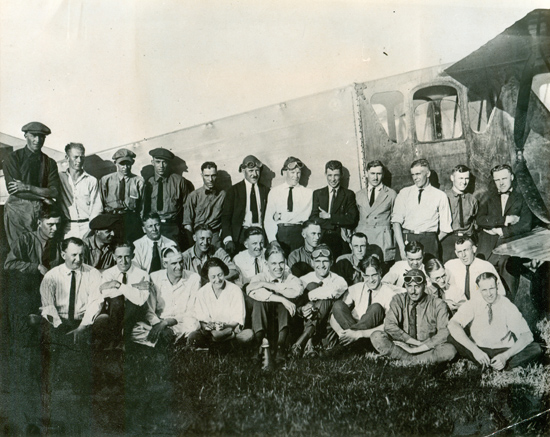 |
The names of the people in this photo are listed below (I enhanced the contrast of the writing in PhotoShop for easier reading). There were two typed cards in the folder with the photograph. Notice that Glenn Messer is added by hand to the bottom one. Two of the people are Register pilots, John Livingston, (fourth from left in the back row with the cap on) and Phoebe Fairgrave Omlie (fourth from the left seated in the front row; Vern Omlie, far left, top row is her husband). The airplane is an Ansaldo cabin plane (compare the window and door geometries in this photograph with the Ansaldo model A-300-C type with 300HP Fiat engine as seen here). Does anyone KNOW any of the unidentified people?
1921 Group Photograph, Annotation
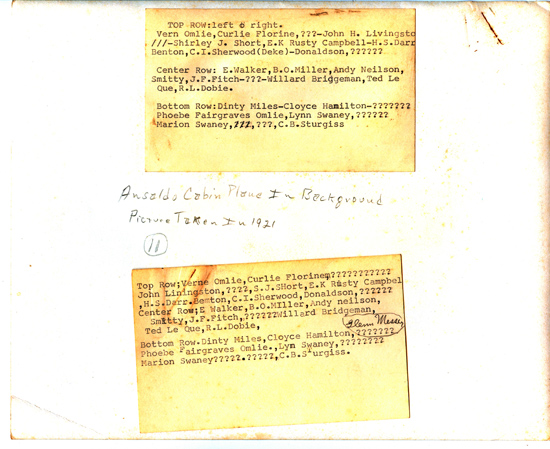 |
Below, a group of four stand in front of a Breguet (probably a model 14, as pictured here with a different exhaust system). This airplane is cited on page 2 of Livingston's letter as a "modified bomber". With straight, vertical, unmuffled exhaust pipes, this engine must have really barked!
1923 Group Photograph, Event & Location Unknown
(source: McDonald)
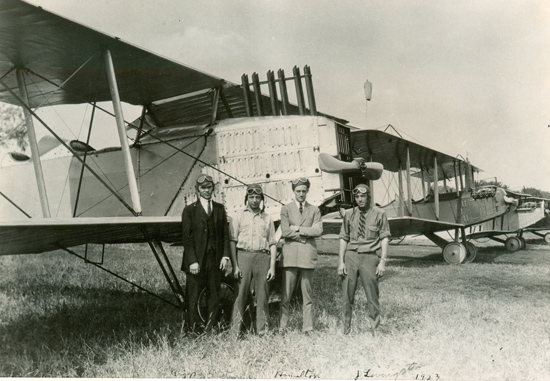 |
John Livingston stands at far right with "Hamilton" next to him. He looks very much like the Cloyce Hamilton identified in the previous group photograph. Below, the annotation on the back of this photograph.
1923 Group Photograph, Annotation
 |
Regarding the photograph above, this update of August 3, 2013 clarifies the people. The site visitor who provides the information states, "I can tell you some more about that photograph. The man on the left is my great-grandfather, Cecil Riggs. On 24 Aug 1980, this photo was published in the Daily Dispatch (Moline, IL) on p. 32 with the following caption.
"Down Memory Lane . . .
Cecil Riggs, Moline, is the owner of this picture taken in 1924 with World War I planes in the background. Names of the planes are the Breguet, Standard, and Jenny. Riggs, on the left, identifies others in the picture as a reporter for a Monmouth newspaper; Cloyce C. Hamilton, and John Livingston, a well-known flyer." |
Below, what appears to be preparation for a classic barnstorming activity: wing walking. The woman identified on the right wing of this JN is Phoebe Omlie.
Phoebe Omlie on the Wing of a Curtiss Jenny
(source: McDonald)
 |
The location, below, is identified as Fairfield, IA. The date is unidentified, but it is probably early to mid-1920s.
Phoebe Omlie on the Wing of a Curtiss Jenny, Annotation
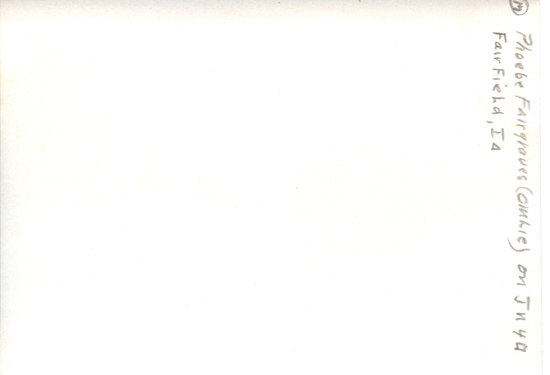 |
Below, John Livingstom poses with a Thomas Morse Scout, which has been modified as stated in the image annotation immediately following.
1923, John Livingston With Modified Thomas-Morse "Tommy"
(source: McDonald)
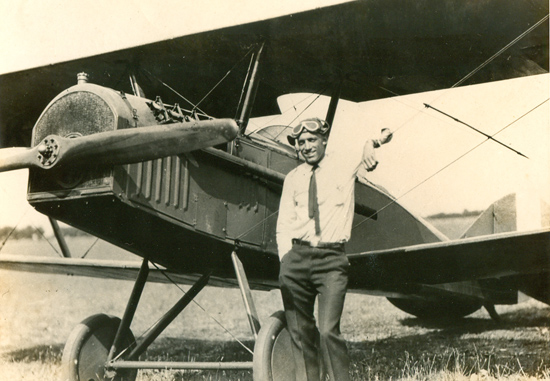 |
1923, John Livingston With Modified Thomas-Morse, Annotation
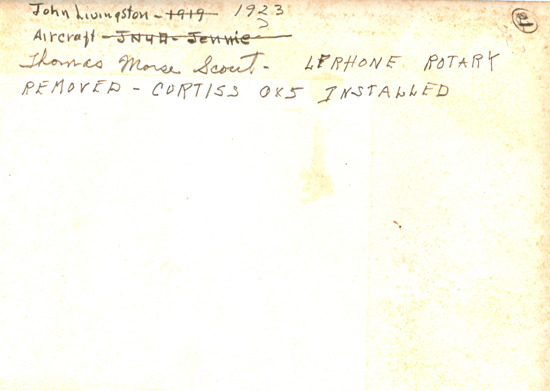 |
Below, Livingston with what is identified as a "K-6 Standard". The date of this image is uncertain, but it was after the formation of Livingston's Midwest Airways Corp. at Monmouth, IL, which would place it sometime between 1922 and 1928 according to his letter, above. It appears everything possible was done to this airplane to increase drag. According to aerofiles.com, many military Standards were surplused into civil use after WWI.
Livingston Standing By a Standard (J-1?) With Curtiss K-6 Engine
(source: McDonald)
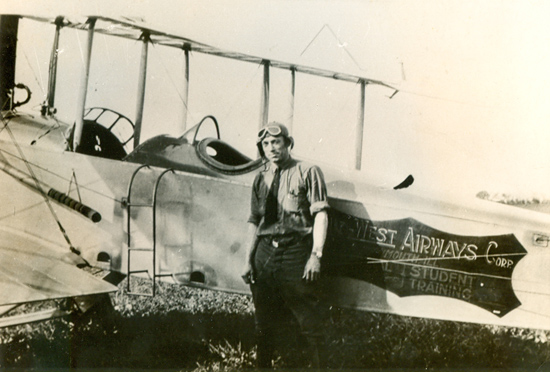 |
Below, a real treasure. It is a composite photograph of pilot images and signatures by the participants in the 1926 Second Annual Ford Reliability Tour, August 7-21, 1926. You can learn about this Tour in the excellent series of descriptions of all the Ford Tours by Leslie Forden here. Livingston's Waco 9 can be seen on page 33 of chapter 2. As well, there is another rendering of the image below on page 38. If you compare the two images, you'll find differences in the numeric labeling of the photographs. Whereas the ones below appear to be handwritten in circles, the ones in the Forden reference are typed on strips. Details, details. Note the map at the center of the board, and compare with the one in chapter 2 on page 26 of Forden.
Composite Signature Board, Ford Reliability Tour, 1926
(source: McDonald)
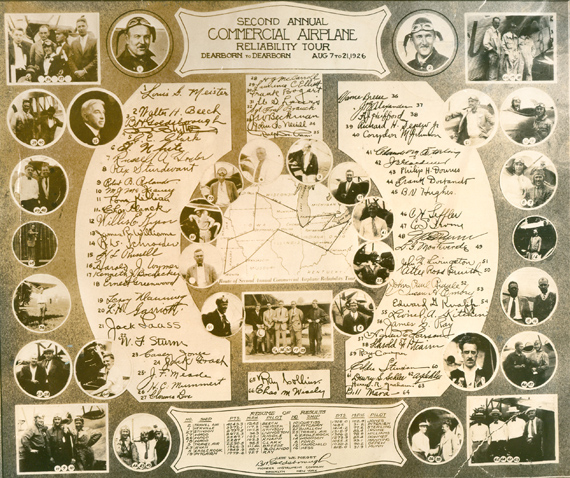 |
Although the 1926 Tour did not pass through Tucson (that would happen, however, in 1928), many of the participants in the Tour did sign the Register at one time or another. Some examples include, Walter Beech, C.E. Clark, Vance Breese, J.B. Alexander, Eddie Stinson and Richard Depew. Look for all their signatures above. An author, Charles Planck, also competed in 1926. Later, in 1942 he would write this book. The signature of Harold Pitcairn, manufacturer of at least eight of the airplanes that visited Tucson over the years (e.g. see NC6708), is at lower right.
Livingston won the Ford Tour of 1929 flying Waco NC604N (not a Register airplane). Below, from the San Diego Aerospace Museum (SDAM), is a photograph of that airplane standing before Livingston's Midwest Airways Corporation hangar.
Livingston's Winning Airplane, Ford Tour, 1929 (Source: SDAM)
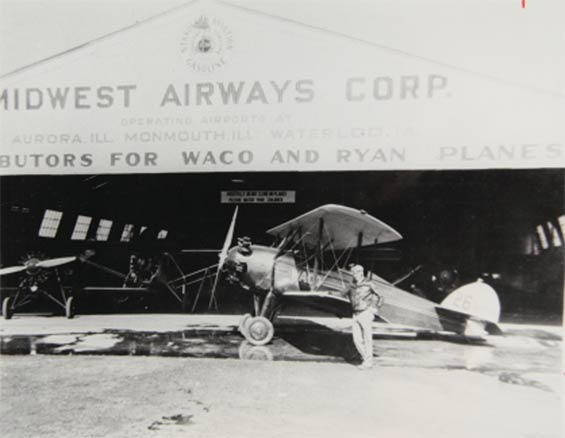 |
Rudder Detail, Waco NC604N (Source: SDAM)
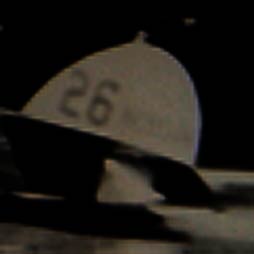 |
The airplane in the photo above is identifiable by its race number, 26, as seen in the PhotoShop-enhanced vignette of the rudder, right. The registration number is not legible. It is difficult, also, to identify the person standing by the airplane, but chances are good that it's Livingston.
Below, a fine image of the Hawkeye Air Transport fleet (Ryan and Waco aircraft) at Waterloo, ca. 1927-28. This was just before Livingston took over the operation at the field, establishing his Waterloo-Des Moines service (see the letter, above, page 3).
Hawkeye Air Transport Fleet, Ca. 1927-28
(source: McDonald)
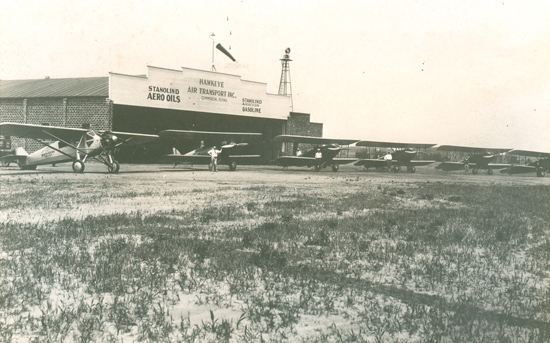 |
Hawkeye Air Transport Fleet, Ca. 1927-28
 |
Below, a 1928 photograph of one of Livingston's 5-place Ryan aircraft with O.P. Harwood. Mr. Harwood worked for Livingston during the short, 11-month life of his Waterloo to Des Moines commuter airline (see Livingston's letter above, page 3).
1928, O.P. Harwood with Ryan Aircraft
(source: McDonald)
 |
The annotation on the back of this photo is brief, below.
1928, O.P. Harwood with Ryan Aircraft, Annotation
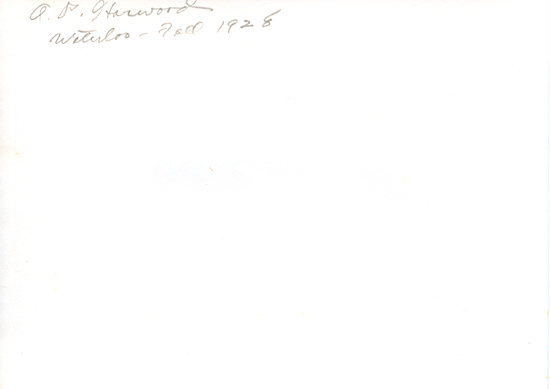 |
Below, Livingston hopping what appears to be a tethered glider in a strong, midwest winter wind.
Evans Glider Built by Livingston, 1928
(source: McDonald)
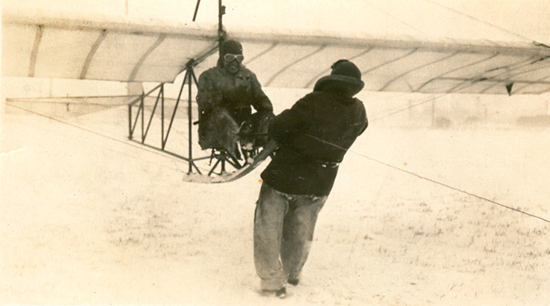 |
The back of this image cites it is an Evans glider, built by Livingston in 1928.
Evans Glider Built by Livingston, 1928, Annotation
 |
Evans gliders were popular training devices as shown by the contemporary advertisement and news article below (these documents are not from Captain McDonald).
Gobles (MI) News, September 13, 1928, #52
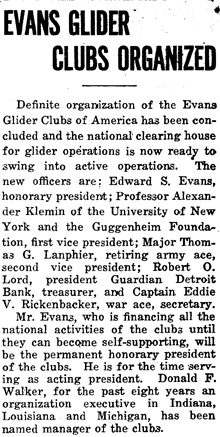 |
Evans Glider Ad, Circa 1930
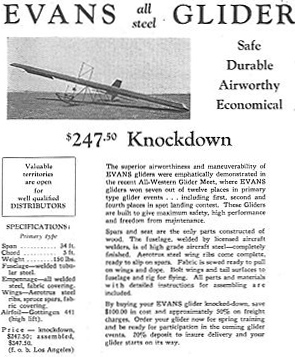 |
Below, we see Livingston posed with his trophy won for placing first in the Class B transcontinental race from New York to Los Angeles during the 1928 National Air Races. The airplane is his Waco, NX7527.
John Livingston With Class B Trophy, 1928 National Air Races
(source: McDonald)
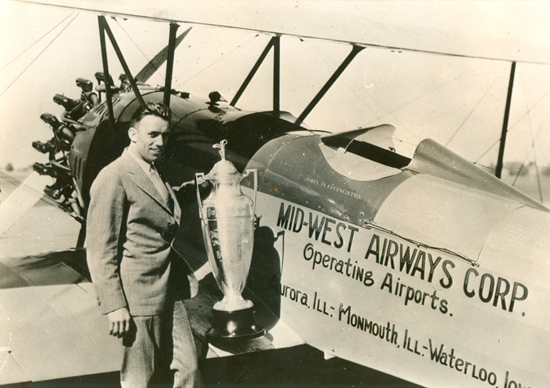 |
The next two images are variations on a theme of victory photos of pilot Livingston with his NX7527. The exact date is unknown, but it is probably circa 1928 when he was successfully racing this airplane.
Livingston in Leather Flight Gear Standing Next to NX7527, Ca. 1928
(source: McDonald)
 |
This image, and several of the others, appear to have been removed from a black paper album, perhaps the album Livingston alludes to in his letter, above.
Livingston in Leather Flight Gear Standing Next to NX7527, Ca. 1928, Annotation
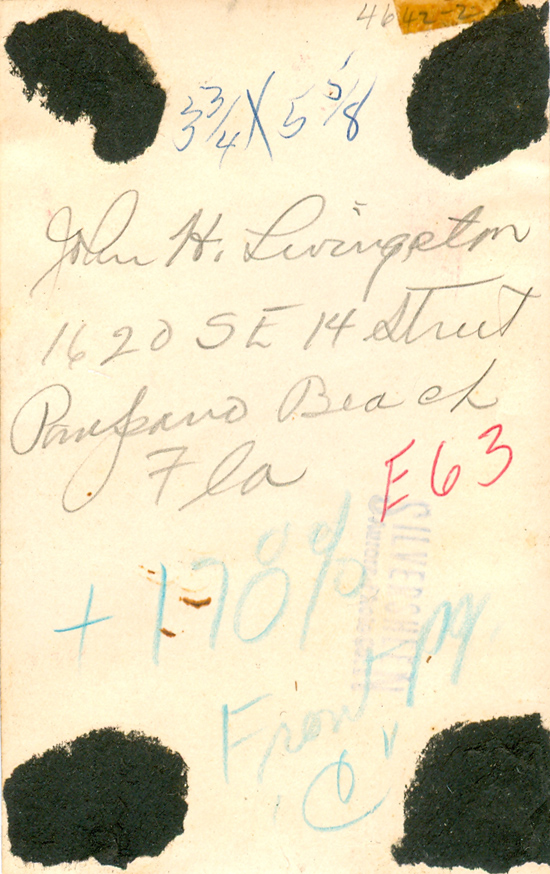 |
Livingston in Leather Flight Gear Standing Next to NX7527, Ca. 1928
(source: McDonald)
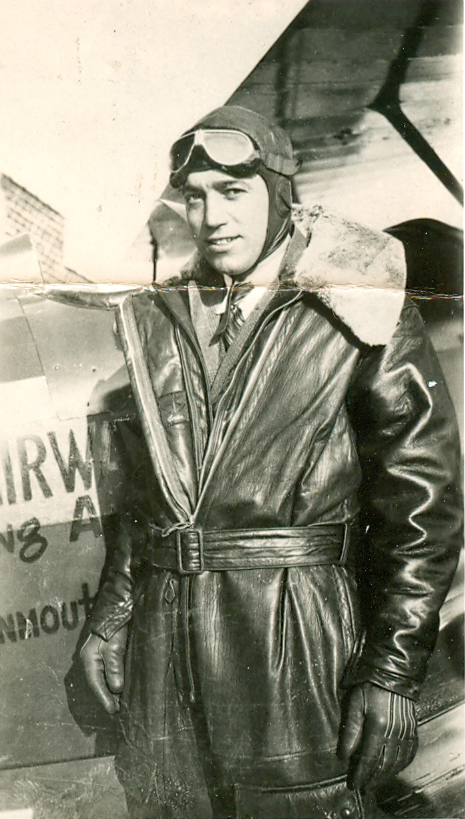 |
Livingston in Leather Flight Gear Standing Next to NX7527, Ca. 1928, Annotation
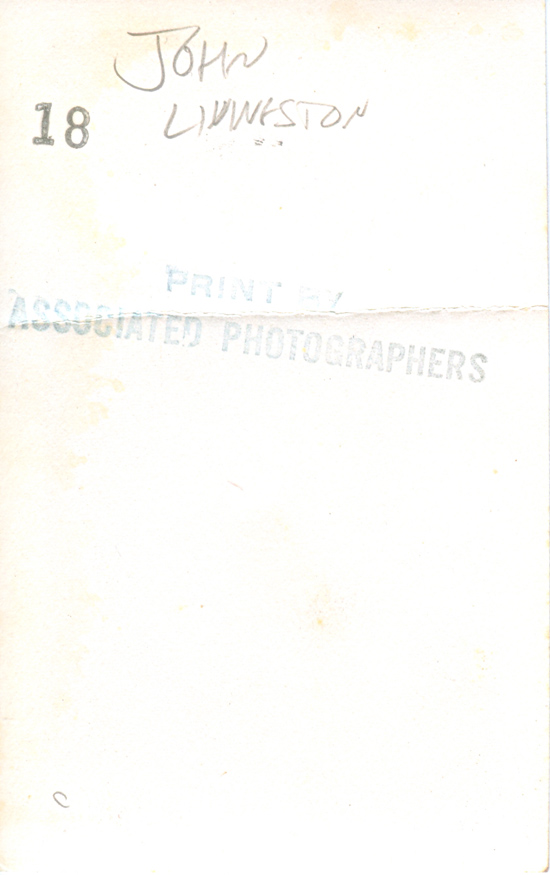 |
The Aurora (IL) Beacon-News of October 3, 1928 carried a full-page testimony to Livingston's victory. According to the letter above, page 3, Livingston was in the midst of the transcontinental air race, New York to Los Angeles.
Aurora (IL) Beacon-News of October 3, 1928
(source: McDonald)
 |
Below, according to aerofiles.com, is NC559V, identified as a Van Alstyne glider. There appears to be a roller coaster in the background.
NC559V, A Van Alstyn Glider
(source: McDonald)
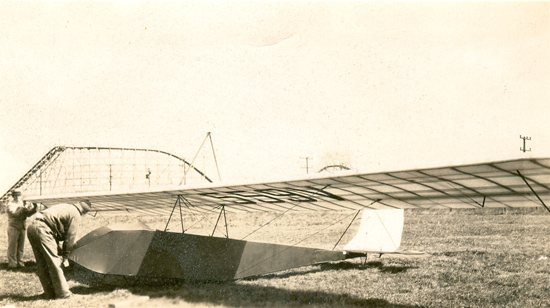 |
Similar to the annotation for the previous glider, the description of this one is brief. Livingston's flight log cites that he earned glider license number 102, but it mentions nothing about total hours spent in gliders during 1929 or any other year. Perhaps he had a separate book for glider time.
NC559V, A Van Alstyn Glider, Annotation
 |
Below, a group picnic photograph from May 21, 1929. Livingston is ninth from the left between the four women. The airplane behind the man with the bicycle is NC7527. The designation "NX" (experimental) was changed sometime between August, 1928 and May, 1929. Given that Livingston mentions in his letter that his Mid-West Airways Corp. Waterloo to Des Moines commuter line lasted about eleven months from the fall of 1928, this may well have been its final group picnic with the commuter service in existence.
Group Picnic, May 21, 1929
(source: McDonald)
 |
Below, a poster/map of the September, 1930 Ford Reliability Tour (National Air Tour). Livingston participated in this two-week event. He flew Waco NC600Y (not a Register airplane) and placed second. According to his flight log, above, he earned $2,000.
Ford Tour Map, 1930
(source: McDonald)
 |
Livingston documents in his letter that he flew a, "replica of Beachy's Pusher". Below is corroboration of that claim. This aircraft belonged to Al Wilson. The registration number was 3378 and, upon magnification, "Al Wilson" can be seen lettered on the the vertical stabilizer just above the number. Wilson brought this aircraft to Tucson September 28, 1930.
In this photo, however, Livingston is the pilot in suit and tie, with leather helmet and goggles, with a big smile on his face. Unidentified biplane at the upper left. The date of this image is unrecorded, but it was certainly taken before September 4, 1932, since Wilson died as the result of injuries in a crash which destroyed this aircraft at the National Air Races at Cleveland on that date. The circumstances of the crash include Register pilot John Miller.
John Livingston Flying Curtiss Pusher Replica Belonging to Al Wilson
(source: McDonald)
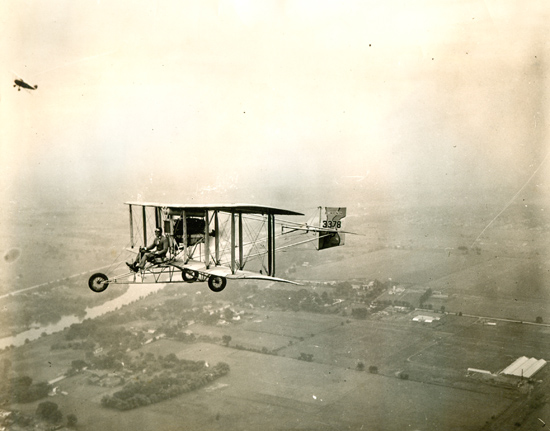 |
The show
and the crash are well documented in the Cleveland Plain Dealer of September 4 ("PUSHER PILOT HURT IN SPILL AT RACES:
Al Wilson in Hospital; Two in Autogyro Escape as Craft Mix
in Stunt"), and September 6 ("WILSON, HURT IN 1910
PLANE, DIES"). As well, the accident was captured on
film and is available on video as “Pylon
Dusters: 1932 and 1938 Air Races”. The segment of this film that shows Al Wilson and John Miller during their dogfight routine is at our MOTION PICTURES page. Click on "Wilson-Miller Dogfight."
The Miami air derbies were held each January. Below, two views of Livingston during that event during 1931 (not documented in the Aircraft Yearbook).
Miami Races, 1931
(source: McDonald)
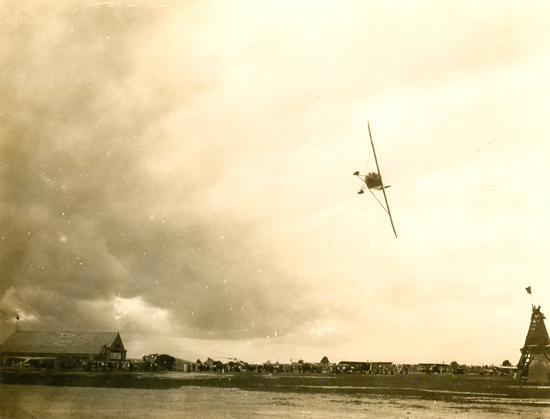 |
Miami Races, 1931
(source: McDonald)
 |
Below, two more action images of Livingston racing Monocoupes at the 1931 and 1932 Cleveland National Air Races (NAR).
1931 Cleveland NAR, Livingston at Base of Pylon
(source: McDonald)
 |
These two photos,and the two above from Miami, give a sense of the aggressiveness with which Livingston raced. As well, when your turn altitude is below the height of the pylon, there can be little chance of a referee calling a missed pylon.
1932 Cleveland NAR, Livingston at Middle of Pylon
(source: McDonald)
 |
Captions on the back of the two photographs above.
Photo Captions, 1931-32 NAR
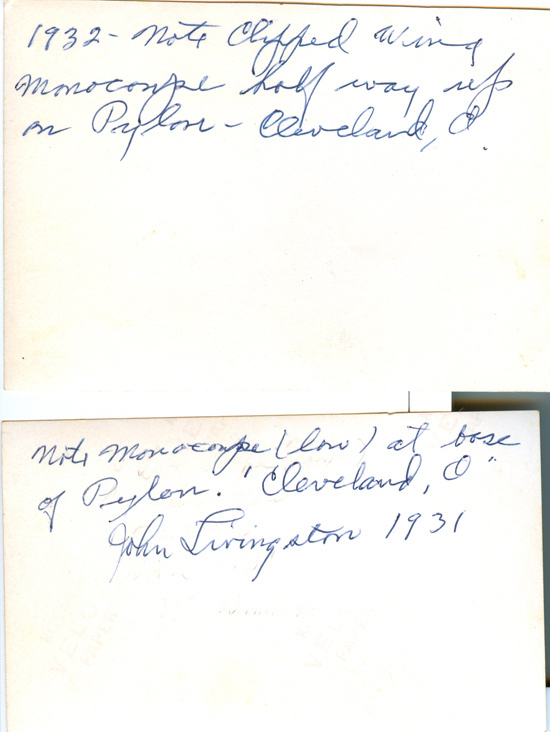 |
Another view of the 1932 NAR and Livingston's clipped-wing Monocoupe, NR501W (the last three characters of the registration number are visible on the bottom of the port wing; see this airplane on the ground, wearing race number 14, in the image nearer the top of this page). This airplane is cited on the earnings page of Livingston's 1929-1942 -pilot flight log exhibited above. He calculated that he earned $2,050 at Cleveland that year, however the tally from the Aircraft Yearbook (1933) summary of earnings only showed $1,245. "Underwood" mentioned in the photo caption refers to friend of dmairfield.org, John Underwood, who has shared many of his vintage photographs and documents with us.
1932 NAR, Monocoupe
(source: McDonald)
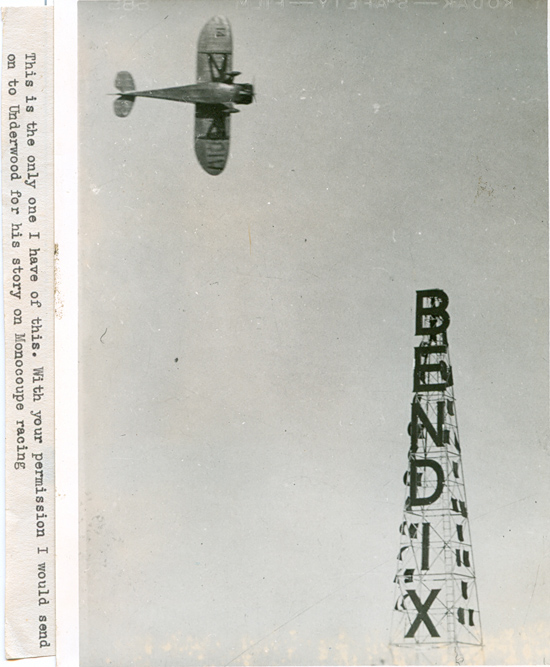 |
Below, courtesy of site visitor Joe Kranz, a U.S. postal cachet signed by Livingston and postmarked September 2, 1932. The cachet commemorates his participation in the National Air Races that year. I include the entire page of Kranz' grandfather's album in order to give you an appreciation for the context of the collection.
U.S. Postal Cachet and Context, John Livingston, September 3, 1932 (Source: Kranz)
 |
The handsome Art Deco stickers were part of race memorabilia. The small article, which appears to be clipped from a rotograveur news section, cites Livingston's win of the Cincinnati Tropy Race for which he won $900. According to the Aircraft Yearbook for 1933, he also took third place in events #4 and #5 ($135 and $150 respectively), 4th place in event #6 ($250), and a third and two first places in three different precision landing contests. All these added up to the $2,050 or the $1,245, whichever you prefer to believe.
The local Waterloo newspaper brings us this cartoon from October, 1932. As suggested by the spread in the Aurora (IL) Beacon-News, above, Livingston was a midwest celebrity.
Cartoon, Waterloo Daily Courier, October 2, 1932
(source: McDonald)
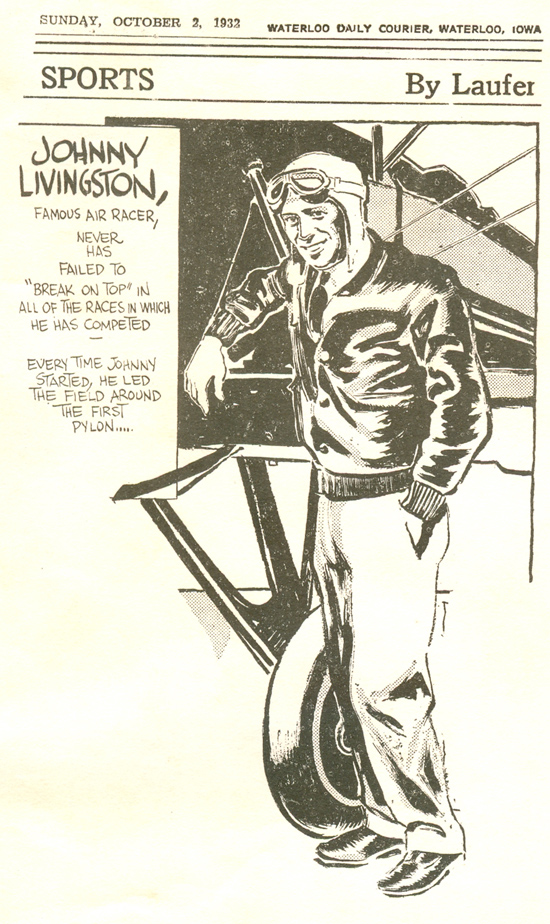 |
The 1939 Miami derby was good to Livingston. He placed first in the 550 and 800 cubic inch classes, flying what he termed the "Clair Bunch coupe". Clare Bunch was a Register pilot. Below, Livingston, becoming gray at the temples, displays his trophies for his Miami victories.
John Livingston, 1939, With Miami Air Derby Trophies
(source: McDonald)
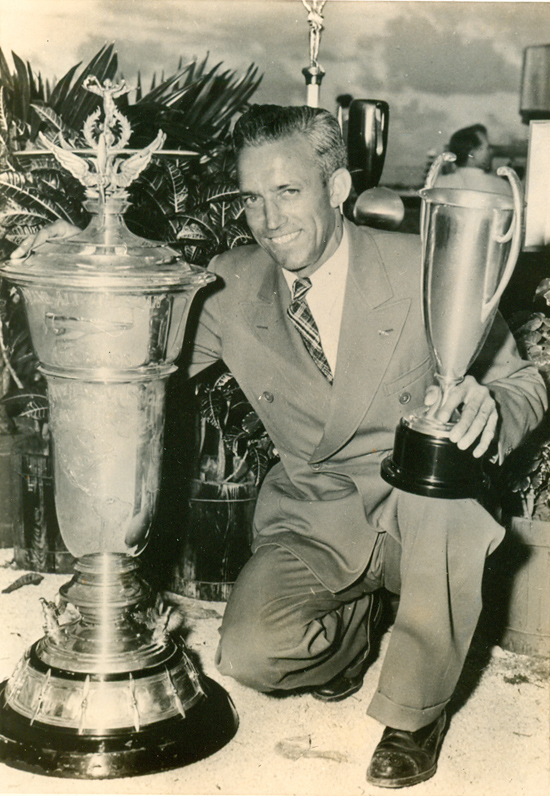 |
These victories are documented in his flight log on page 32.
Below, a color image of Livingston from 1965. From the weather conditions, the location is probably Florida.
John Livingston, February 28, 1965
(source: McDonald)
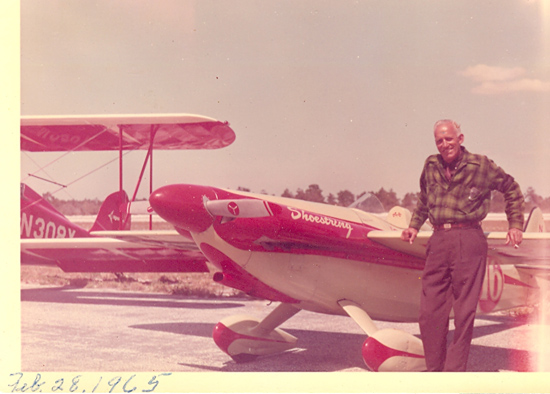 |
"Shoestring" was a post-WWII Formula One "midget" air racer originally built in 1949.
Below, a photograph from 1966 taken at Rockford, IL. Livingston is posed with a 200HP Monocoupe belonging to Bill Hutchins.
John Livingston, 1966, Rockford, IL
(source: McDonald)
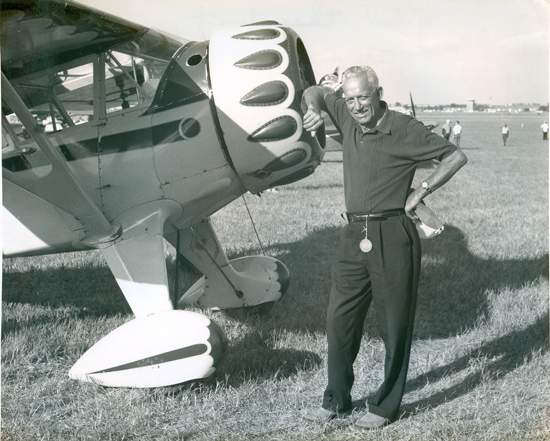 |
The annotation on the back of this image documents ownership of the airplane and that the photograph was taken by John Underwood.
John Livingston, 1966, Rockford, IL, Annotation
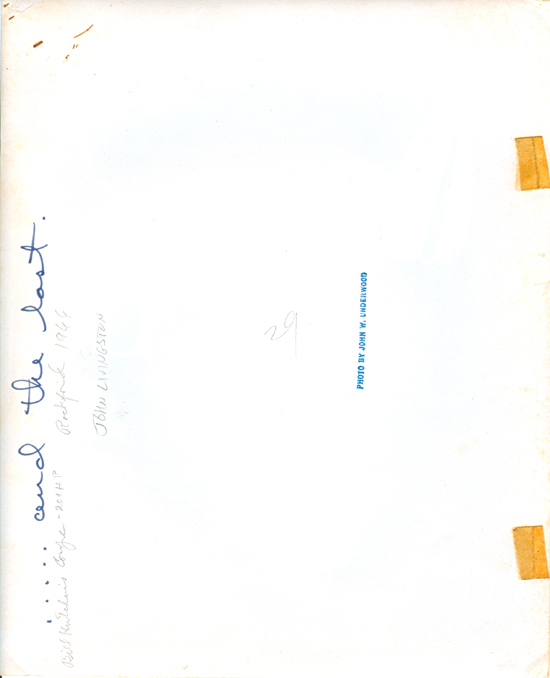 |
Below, Livingston with a Pitts belonging to Art Teulon.
John Livingston, 1970, Posing With a Pitts
(source: McDonald)
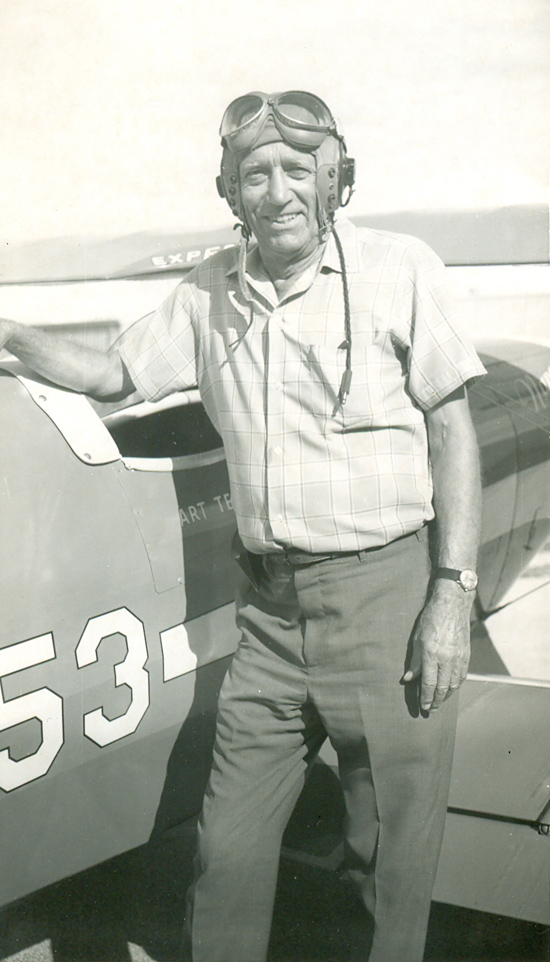 |
John Livingston, 1970, Posing With a Pitts, Annotation
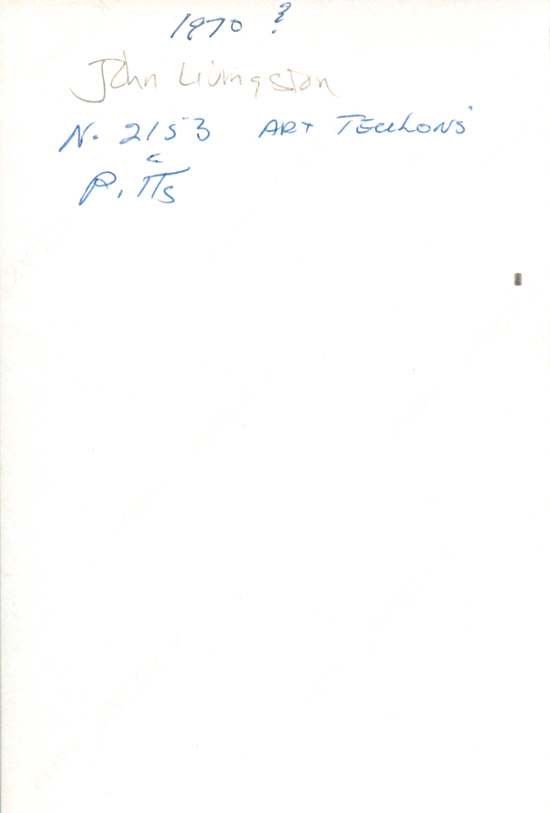 |
Below, a color image of John Livingston, left, in later life.
John Livingston, Left, Date, Location and Other Person Unidentified
(source: McDonald)
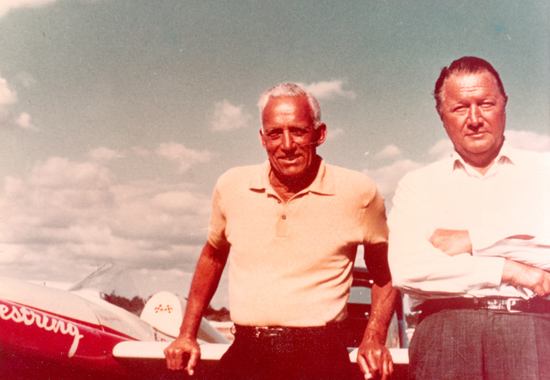 |
Below, Livingston reviews his accomplishements about two years before his passing. The poster at upper left, and the small image top, center, are both exhibited on this page, above.
John Livingston and His Trophies, August 8, 1972
(source: McDonald)
 |
The largest trophy is identifiable as the Grauman Trophy awarded for his victory in the 1928 transcontinental race. The same trophy is exhibited above, here. He holds a model of his Monocoupe NR105W. Does anyone KNOW where these trophies, or the photo album he alludes to in his letter, above, are?
Just months before his passing, Livingston was involved with Curtis Pitts and Pitts Aviation Enterprises, Homestead, FL, in a project that involved wing rigging to improve flight performance. This document (PDF 24MB) displays a diagram and six pages of correspondence between Livingston and Pitts.
The correspondence discusses Livingston's invention of an innovative tool for aligning ("rigging") the wings of Pitts aircraft. Livingston was beginning what looked like a lucrative rigging service to rig the wings of Pitts aircraft for their owners. He passed away before that business really got off the ground.
Below, Livingston's obituary from the New York Times. This is a surprisingly brief obituary for such an accomplished aviator.
J. Livingston Obituary, New York Times, July 3, 1974
Des Moines, Iowa, July 2 - John H. Livingston, the man who inspired the best-selling novel "Jonathan Livingston Seagull," died Sunday at the Pompano Beach (Fla.) Airport soon after completing his last plane ride.
Richard Bach, a former Iowa Air Guard pilot, has said his best-selling book about a free-wheeling seagull was inspired by Mr. Livingston.
Johnny Livingston, as he was known, moved many years ago from Iowa to Florida. He was one of the country's top pilots during the barnstorming days of the nineteen-twenties and -thirties.
From 1928 through 1933, Mr. Livingston won 79 first places, 43 seconds and 15 thirds in 139 races throughout the country, many of them at Cleveland. He won first place and $13,910 in 1928 in a cross-country race from New York to Los Angeles.
Mr. Livingston leaves his wife, Wavelle, two brothers and four sisters. |
---o0o---
Update of 11/21/10 Earlier in 2010 I heard via email from the grand niece, Stacey Roelofs, of pilot Livingston. She informed me that Livingston's younger sister was very much interested in this Web page. Below is a photograph of Evelyn (Livingston) Thiel, John's sister and only surviving sibling. She is posed, seated, with her daughter (top) and grand niece Roelofs. The resemblance between Ms. Theil and John Livingston is striking.
Livingston Family, November 20, 2010 (Source: Roelofs)
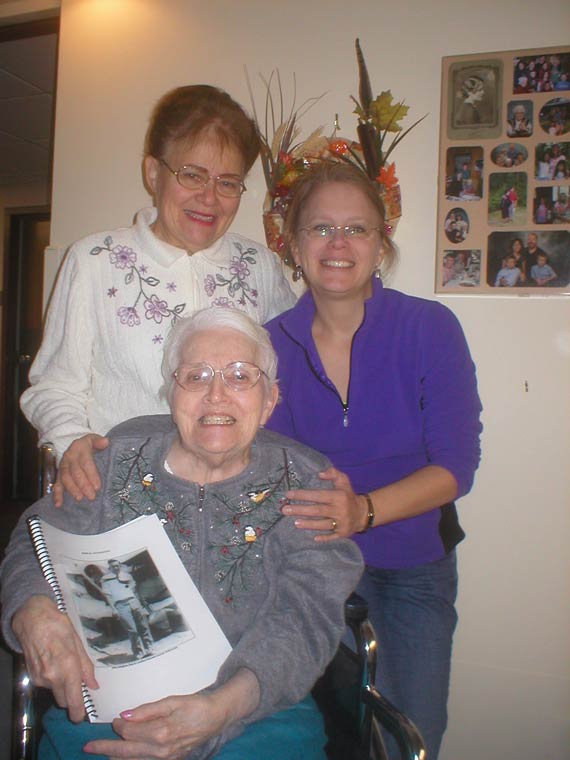 |
Ms. Roelofs printed this Web page (60+ pages including the PDFs!), bound it and presented it to her grandmother. She holds it today at age 97.
Last but not least, below is a photo of yet another generation of Livingston aviators. Evelyn's great-grandson Eli sits in the cockpit of John's brother "Bite" Livingston's airplane.
Eli Roelofs in Bite Livingston's Airplane, November, 2010 (Source: Roelofs)
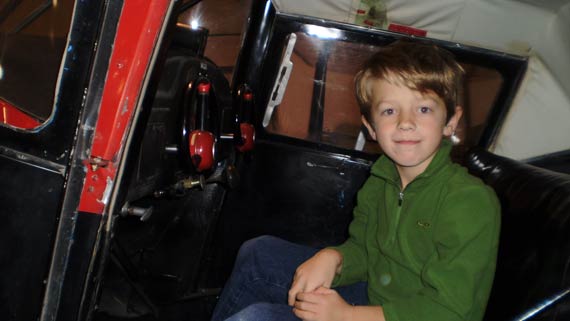 |
Now you know why I do this work.
---o0o---
Dossier 2.1.4
UPLOADED: 2/14/06 REVISED: 10/07/07, 10/13/07, 04/16/08, 05/14/09, 03/09/10, 11/21/10, 07/04/11
|




